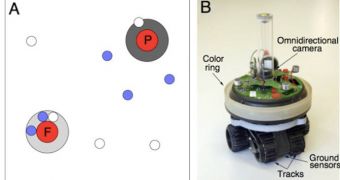According to a new set of experiments, it would appear that robots have the ability to deceive other robots, especially after they are specifically bred to do so. In the studies, small machines with artificial, animal-derived computer brains, quickly learned to deceive each other, if the reward was well worth. The find may help accelerate the field of robotics, and also design more intelligent machines that would not give away any information willingly, Wired informs.
The new robots were the size of a football, and they were laden with sensors, bright, flashy lights and wheels. They were placed on the floor, among discs of paper standing in for either “food” or “poison.” The original machines simply roamed the surfaces, emitting light randomly. After each of the trials, in which they had to find as much food as possible, the researchers would copy the digital brain of the most successful machine, and insert it into the next generation of robots, alongside a few changes, so as to favor “evolution.”
After a few generations, some of the machines learned how to recognize flashing lights emitted by others as a clear indicator that food was nearby, and jumped right in the middle of the action, pushing and showing others out of their path. This is what biologists would normally call an evolution “bottleneck,” as, in reality, only a few species would survive. But the most amazing thing that was observed was the fact that some of the robots that found food first learned to mute their flashy signals, so as to draw less attention from “scavengers.”
“Evolutionary robotic systems implicitly encompass many behavioral components, thus allowing for an unbiased investigation of the factors driving signal evolution. The great degree of realism provided by evolutionary robotic systems thus provides a powerful tool for studies that cannot readily be performed with real organisms,” the authors of a new study accompanying the experiments, published in the Monday issue of the respected scientific journal Proceedings of the National Academy of Sciences (PNAS), say.

 14 DAY TRIAL //
14 DAY TRIAL //